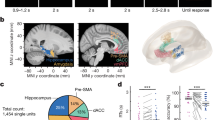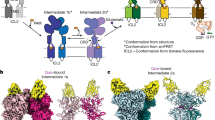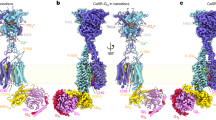Abstract
The responses of vertebrate neurones to glutamate involve at least three receptor types1. One of these, the NMDA receptor (so called because of its specific activation by N-methyl-D-aspartate), induces responses presenting a peculiar voltage sensitivity2–6. Above resting potential, the current induced by a given dose of glutamate (or NMDA) increases when the cell is depolarized4–6. This is contrary to what is observed at classical excitatory synapses, and recalls the properties of ‘regenerative’ systems like the Na+ conductance of the action potential. Indeed, recent studies of L-glutamate, L-aspartate and NMDA-induced currents have indicated that the current–voltage (I–V) relationship can show a region of ‘negative conductance’ and that the application of these agonists can lead to a regenerative depolarization4–6. Furthermore, the NMDA response is greatly potentiated by reducing the extracellular Mg2+ concentration ([Mg2+]o) below the physiological level (∼1 mM)7,8. By analysing the responses of mouse central neurones to glutamate using the patch-clamp technique9, we have now found a link between voltage sensitivity and Mg2+ sensitivity. In Mg2+-free solutions, L-glutamate, L-aspartate and NMDA open cation channels, the properties of which are voltage independent. In the presence of Mg2+, the single-channel currentsmeasured at resting potential are chopped in bursts andthe probability of opening of the channels is reduced. Both effects increase steeply with hyper-polarization, thereby accounting for the negative slope of the I–V relationship of the glutamate response. Thus, the voltage dependence of the NMDA receptor-linked conductance appears to be a consequence of the voltage dependence of the Mg2+ block and its interpretation does not require the implication of an intramembrane voltage-dependent ‘gate’.
This is a preview of subscription content, access via your institution
Access options
Subscribe to this journal
Receive 51 print issues and online access
$199.00 per year
only $3.90 per issue
Buy this article
- Purchase on Springer Link
- Instant access to full article PDF
Prices may be subject to local taxes which are calculated during checkout
Similar content being viewed by others
References
Watkins, J. C. & Evans, R. H. A. Rev. Pharmac. 21, 165–205 (1981).
Shapovalov, A. I., Shiriaev, B. I. & Velumian, A. A. J. Physiol., Lond. 279, 437–455 (1978).
Engberg, I., Flatman, J. A. & Lambert, J. D. C. J. Physiol., Lond. 288, 227–261 (1969).
MacDonald, J. F., Porietis, A. V. & Wojtowicz, J. M. Brain Res. 237, 248–253 (1982).
MacDonald, J. F. & Porietis, A. V. Soc. Neurosci, Abstr. 8, 796 (1982).
Flatman, J. A., Schwindt, P. C., Crill, W. E. & Stafstrom, C. E. Brain Res. 266, 169–173 (1983).
Ault, B., Evans, R. H., Francis, A. A., Oakes, D. J. & Watkins, J. C. J. Physiol., Lond. 307, 413–428 (1980).
Scatton, B. & Lehmann, J. Nature 297, 422–424 (1982).
Hamill, O. P., Marty, A., Neher, E., Sakmann, B. & Sigworth, F. Pflügers Arch. ges. Physiol. 391, 85–100 (1981).
Beaujouan, J. C. et al. Molec. Pharmac. 22, 48–55 (1982).
Neher, E. & Stevens, C. F. A. Rev. Biophys. Bioengng 6, 48–381 (1977).
Jan, L. Y. & Jan, Y. N. J. Physiol., Lond. 262, 215–236 (1976).
Anwyl, R. J. Physiol., Lond. 273, 367–388 (1977).
Neher, E. & Steinbach, J. H. J. Physiol., Lond. 277, 153–176 (1978).
Armstrong, C. M. J. gen. Physiol. 58, 413–437 (1971).
Adams, P. R. J. Physiol., Lond. 260, 531–552 (1976).
Fukushima, Y. J. Physiol., Lond. 331, 311–331 (1982).
Colquhoun, D. & Hawkes, A. G. in Single Channel Recording (eds Sakmann, B. & Neher, E.) 135–175 (Plenum, New York, 1983).
Neher, E. J. Physiol., Lond. 339, 663–678 (1983).
Ascher, P., Marty, A. & Neild, T-O. J. Physiol., Lond. 278, 207–235 (1978).
Clapham, D. & Neher, E. Naunyn-Schmiedebergs Archs Pharmak. 322, R62, 1983: J. Physiol., Lond. (in the press).
Marty, A. Pflügers Arch. ges. Physiol. 396, 179–181 (1983).
Trautmann, A. & Siegelbaum, S. in Single Channel Recording (Sakmann, B. & Neher, E.) 473–480 (Plenum, New York, 1983).
Author information
Authors and Affiliations
Rights and permissions
About this article
Cite this article
Nowak, L., Bregestovski, P., Ascher, P. et al. Magnesium gates glutamate-activated channels in mouse central neurones. Nature 307, 462–465 (1984). https://doi.org/10.1038/307462a0
Received:
Accepted:
Issue Date:
DOI: https://doi.org/10.1038/307462a0
This article is cited by
-
Inhibition of the NMDA Currents by Probenecid in Amygdaloid Kindling Epilepsy Model
Molecular Neurobiology (2024)
-
The effects of the NMDAR co-agonist d-serine on the structure and function of optic tectal neurons in the developing visual system
Scientific Reports (2023)
-
Cortical inhibitory but not excitatory synaptic transmission and circuit refinement are altered after the deletion of NMDA receptors during early development
Scientific Reports (2023)
-
Excitation–transcription coupling, neuronal gene expression and synaptic plasticity
Nature Reviews Neuroscience (2023)
-
Aryl Hydrocarbon Receptor in Glia Cells: A Plausible Glutamatergic Neurotransmission Orchestrator
Neurotoxicity Research (2023)
Comments
By submitting a comment you agree to abide by our Terms and Community Guidelines. If you find something abusive or that does not comply with our terms or guidelines please flag it as inappropriate.



